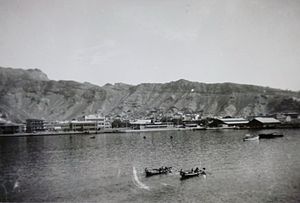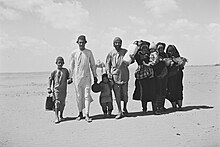1947 Aden riots
| 1947 Aden riots | ||||
|---|---|---|---|---|
| Part of Spillover of the 1947–48 Civil War in Mandatory Palestine | ||||
 Aden from the Port of Aden, 1949 | ||||
| Date | 2–4 December 1947 | |||
| Location | 12°48′N 45°02′E / 12.800°N 45.033°E | |||
| Caused by | Disputes over United Nations Partition Plan for Palestine | |||
| Methods | Rioting, melee attacks | |||
| Parties to the civil conflict | ||||
| ||||
| Casualties and losses | ||||
| ||||
| Part of a series on |
| Jewish exodus from Arab and Muslim countries |
|---|
 |
| Background |
| Antisemitism in the Arab world |
| Exodus by country |
| Remembrance |
| Related topics |
The 1947 Aden riots were three days of violence in which the Jewish community of Aden (in modern-day Yemen) was attacked by members of the Yemeni-Arab community in early December, following the approval of the United Nations Partition Plan for Palestine on 29 November 1947. It was one of the most violent pogroms in modern times against Mizrahi-Jewish communities in the Middle East, resulting in the deaths of 76–82 Jews,[1] 33 Arabs, 4 Muslim Indians, and one Somali,[2] as well as wide-scale devastation of the local Jewish community of Aden.[1][3]
The riots were a significant embarrassment for the British government, particularly given that the British-raised Aden Protectorate Levies were blamed for causing many unnecessary deaths.[4]
Background[]
By the mid-20th century, Aden was under British rule (today part of Yemen) and had a community of around 5,000 Jews living alongside the Muslim population.[5][1] In the 1930s, there were rare religiously-motivated outbreaks of anti-Jewish violence, as well as a relatively small riot in May 1932 in which Muslims accused Jews of throwing excrement into a mosque courtyard.[5][6] Sixty people, including 25 Jews, were injured, but there were no fatalities.[7] The Farhi synagogue was desecrated.[6]
In the 1940s, visits of Palestinian Arabs to Aden and expressions of anti-Jewish sentiments became common.[5] The Adenese-educated Arab population had become exposed to Egyptian newspapers, as well as radio broadcasts of Voice of the Arabs from Cairo, which incited political awareness and prepared the grounds for the anti-Jewish riot of November 1947 and later the 1967 withdrawal of the last British forces.[5]
United Nations Partition Plan for Palestine[]
On 29 November 1947, the United Nations General Assembly adopted Resolution 181(II), titled: "Recommendation to the United Kingdom, as the mandatory Power for Palestine, and to all other Members of the United Nations the adoption and implementation, with regard to the future government of Palestine, of the Plan of Partition with Economic Union".[8]
This was an attempt to resolve the Arab-Jewish conflict by partitioning Mandatory Palestine into "Independent Arab and Jewish States and the Special International Regime for the City of Jerusalem". Following the vote by the UN on partition of Mandatory Palestine, wide scale protests took place across the Arab countries and communities, with Aden being no exception.[9]
Riots[]
The riots occurred in December 1947, several days after the United Nations' approval of the partition plan.
On 2 December, a three-day strike was called to protest the decision.[10] Demonstrations in the Jewish quarter of Aden led to stone and bottle throwing between Jews and Muslims.[11] Jewish houses and shops were looted, and military control was declared when the crisis exceeded the capacity of the small police force.[11] The main military force available was the 1,800-strong Aden Protectorate Levies who were locally recruited soldiers with British and Arab officers.[11] Assistance was also received from several British warships, which sent landing parties, and the equivalent of two companies of British infantry flown in from the Canal Zone.[10] Order was not restored until 6 December.[11] The British government was severely embarrassed by the riots, noting privately that they were urging the Arab states to protect their Jews when they themselves were unable to.[10]
On the second day, rifle fire began.[11] The Levies proved unreliable and worse; some fired indiscriminately and probably contributed to the casualties.[11]
The main violence of the riots occurred in three locations. In Aden town (also called Crater), an attempt to impose a curfew was largely unsuccessful.[11] Jewish schools and houses were looted and set alight.[11] In the port towns of Steamer Point and Tawahi, most of the Jews were evacuated but some whose presence was not known to the police were killed.[11] Several Arabs who were apparently innocent were shot accidentally.[11] In the Arab town of Sheikh Othman, which had a large Jewish compound, a military contingent arrived to evacuate the 750 Jews to safety. However, several declined to leave and were later found dead.[11]
Casualties[]
The official casualty count was 76–82 Jews (6 persons were unidentified) and 38 Arabs killed, and 76 Jews wounded.[11] At least 87 Arabs were known to have been wounded but many others failed to report their condition.[11] The dead included one Indian Medical Officer and one Levy.[11]
More than 100 Jewish shops were looted and 30 houses burned.[11] An official enquiry conducted by Sir Harry Trusted determined that many individual Levies were sympathetic to the rioters and did not act to control them.[11] Nine Levies were imprisoned for looting.[11] Trusted put most of the blame on Yemeni "coolies," workers temporarily in the country who "have a low standard of life, are illiterate, fanatical and, when excited, may be savage."[11] He did not find claims of Jewish sniping to be convincing, though the Governor Sir Reginald Champion secretly reported to the British government that the two military fatalities were killed "almost certainly by Jewish sniper."[10] Jewish leaders acknowledged "many instances of Arabs and Indians sheltering and otherwise befriending their Jewish neighbours."[11]
Aftermath[]
The Aden government established a second enquiry, under magistrate K. Bochgaard, to consider claims for compensation.[12] Claims totalling more than one million pounds were submitted, exceeding the total annual income of the colony.[12] On the grounds that most of the damage was inflicted by non-residents of Aden, Bochgaard awarded £240,000 with a maximum of £7,500 per claim.[12] The Aden government then further reduced the maximum per claim to £300 with some options for interest-free loans, much to the anger of the Aden Jewish community.[12]
Shortly after the riots, Aden's Jewish community almost entirely left, together with most of the Yemeni Jewish community.[citation needed]
See also[]
- 1945 Cairo pogrom
- 1945 Tripoli pogrom
- Farhud
- Grand Synagogue of Aden, was destroyed during the 1947 Aden riots
References[]
- ^ Jump up to: a b c Aderet, Ofer (30 November 2016). "Jews of Aden recall the pogrom sparked by UN vote on Palestine partition plan". Haaretz. Retrieved 2 December 2016.
- ^ Parfitt, Tudor (1996), The Road to Redemption: The Jews of the Yemen 1900-1950, (Brill's Series in Jewish Studies) XVII, Brill, ISBN 9789004105447
- ^ Goldsmith, Dani (6 December 2017). "Murder, looting, burning: Remembering the Aden riots of 1947". Times of Israel. Retrieved 7 December 2017.
- ^ Parfitt 1996.
- ^ Jump up to: a b c d Ahroni, R. 1994. The Jews of the British Crown Colony of Aden: History, Culture, and Ethnic Relations. Brill. pp. 210-11.
- ^ Jump up to: a b Tudor Parfitt (1996). The Road to Redemption—The Jews of the Yemen 1900-1950. Leiden: E. J. Brill. pp. 128–129.
- ^ Secretary of State for India, House of Commons debates of May 30, 1932 and June 1, 1932; however, according to John Willis (1997). "Colonial Policing in Aden, 1937-1967". The Arab Studies Journal. 5 (1): 57–91. there was one fatality.
- ^ "A/RES/181(II) of 29 November 1947". domino.un.org. 1947. Retrieved 1 October 2019.
- ^ Parfitt 1996, p. 167.
- ^ Jump up to: a b c d Tudor Parfitt (1996). The Road to Redemption—The Jews of the Yemen 1900-1950. Leiden: E. J. Brill. pp. 165–168.
- ^ Jump up to: a b c d e f g h i j k l m n o p q r s Harry Trusted (1948). Report of the Commission of Enquiry into Disturbances in Aden, December 1947. Colonial No. 233. London: His Majesty's Stationery Office.
- ^ Jump up to: a b c d Reuben Ahroni (1994). The Jews of the British Crown Colony of Aden. E.J. Brill. pp. 224–226.
- Mass murder in 1947
- Anti-Jewish pogroms by Muslims 1941-49
- Anti-Jewish pogroms by Muslims
- Antisemitism in Yemen
- Ethnic riots
- 1947–1948 civil war in Mandatory Palestine
- 20th century in the Colony of Aden
- 1947 in Asia
- 1947 in the British Empire
- December 1947 events
- 1947 riots
- 1947 in Judaism
